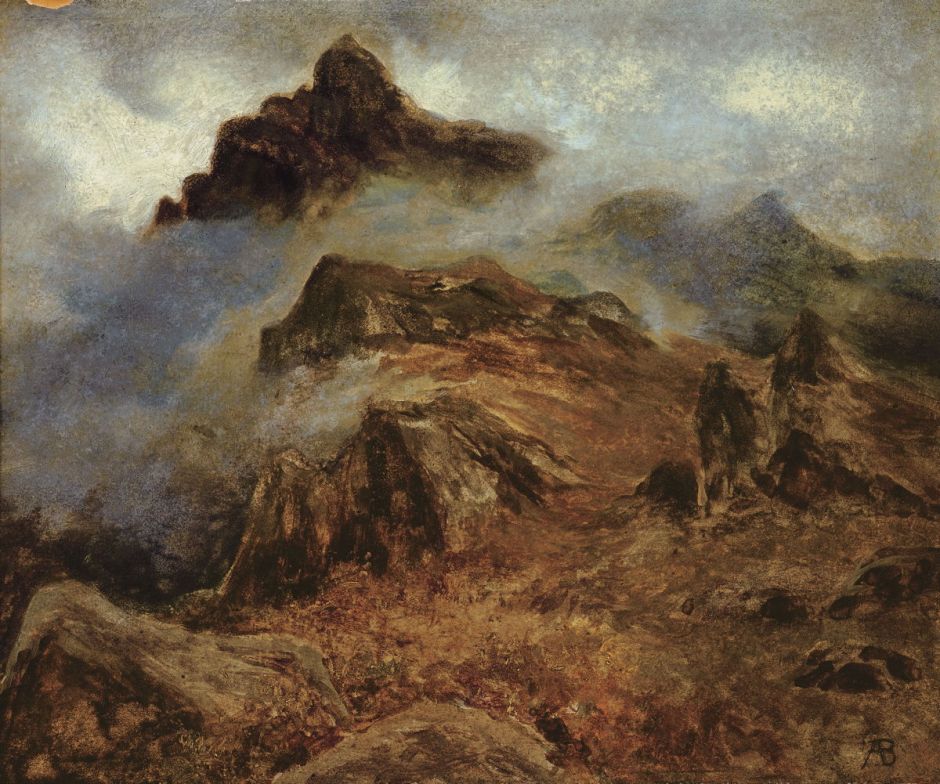When you look at any of Albert Bierstadt‘s large finished paintings, with their studio-perfect paint layer and great detail, you could be forgiven for wondering how he qualifies for this series of expeditionary artists. Like Frederic Edwin Church, each of his images was carefully assembled from dozens of drawings, sketches and studies made in front of his awe-inspiring motif, many when he was in the company of a US government land surveyor.
Bierstadt was born in Germany, but his family emigrated to New Bedford, MA, when he was still a baby. By the time he was in his early twenties, he was becoming a proficient painter in oils, and in 1853, when he was twenty-three, he left New England to study painting in Düsseldorf, Germany, then one of the leading schools of landscape painting in Europe.

When he was still a student in 1855 he made this idyllic view of A Rustic Mill which is an overshot watermill, being fed along a wooden aqueduct. In contrast to many of the other European paintings of mills from this period, this appears in an excellent state of repair and prosperous.
Bierstadt returned to New Bedford in 1857, where he was soon able to paint for his living, thanks to good critical reception the following year.

On his way back to the USA, Bierstadt visited Capri, where he painted Fishing Boats at Capri (1857) in oils on paper, suggesting that it may well have been started in front of the motif, and is quite unlike his mature style. His beach is perhaps a little too cluttered, but he has used a rich variety of techniques to model surface textures.

He seems to have painted The Marina Piccola, Capri on canvas in 1859, before making his first journey westward, and it’s more typical of the drama of his mature style. This smaller harbour is on the south side of the island, to the south-west of the town of Capri, and this view looks to the east, showing the sea stacks of the Faraglioni in the distance, at the right.
Having already established his preference for painting grand views of mountains, Bierstadt first travelled west towards the Rocky Mountains in 1859, in the company of Frederick W Lander, who was surveying for the US government. Bierstadt established a pattern of sketching and photographing spectacular scenery, then returning to his studio in the Tenth Street Studio Building in New York and turning that material into large finished oil paintings.
Bierstadt had learned this traditional landscape technique based on drawing and sketches in front of the motif. It contrasted with the growing enthusiasm for plein air oil sketches as developed by the likes of Camille Corot in the Roman Campagna, and inherited by the Impressionists.

This undated pencil Study of Rocks and Trees by a Lake is typical of a great many he gathered in his sketchbooks when travelling.

He also made painterly oil sketches such as this undated view of Snow in the Rockies on paper or board.

Some of his paintings made in the field, such as this Surveyor’s Wagon in the Rockies from 1859, were worked in greater detail. This gives a good idea of the better travelling conditions when he was with Lander’s survey team.

Once he was back in his New York studio, he assembled drawings and sketches into more idealised landscapes, such as this from 1860, showing Wind River Country.

Like John Constable, some of his late studies, such as On the Sweetwater near the Devil’s Gate from 1860, are more detailed and appear to have been made in the studio, although this is still relatively small and painted on millboard.

Even his smaller finished canvases, such as this view of Indians Spear Fishing from 1862, contain an astonishing amount of detail, and inspire disproportionate awe.
In 1863, Bierstadt was drafted to serve in the Civil War. As was not uncommon practice at the time, he paid a substitute and travelled west with the author Fitz Hugh Ludlow to amass more material for his studio paintings.

He painted this Study of Rocky Mountains on paper in 1863, almost certainly in front of the motif. It has been suggested that this was one of several oil sketches which he used when composing The Rocky Mountains, Lander’s Peak (below), although I can’t see any passage in the finished painting which matches this.

Bierstadt’s The Rocky Mountains, Lander’s Peak (1863) was one of his most successful paintings based on the studies from his first (1859) visit to the west. This shows a summit of 3,187 metres (10,456 feet), which the surveyors named after a general who died in the Civil War. The First Nation people shown are Shoshone, who Bierstadt recognised would soon only be known in history. He sold this painting in 1865 for the sum of $25,000, at the time a record and in today’s values probably towards half a million dollars.

